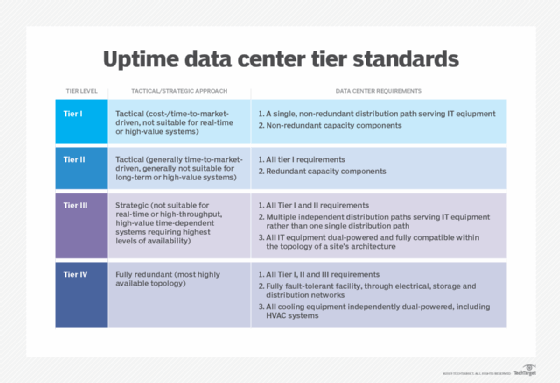
Data Center Standards (Tiers I-IV)
For those in the data center industry, familiarity with The Uptime Institute’s tier ratings is crucial for distinguishing between data center facilities. The Uptime Institute has been at the forefront of data center classification for over two decades, using their Tier Standards to differentiate between various data centers. So, what exactly are Data Center Tier Standards, and why do they hold such significance?
Uptime Institute’s Tier Standard System
Data center standards serve to assess the quality and reliability of a facility’s server hosting capabilities. The Uptime Institute employs a four-tier ranking system as a benchmark for evaluating data center reliability. This proprietary system begins with Tier I data centers, essentially warehouses with power, and progresses to Tier IV data centers, providing 2N redundant power and cooling, along with a 99.99% uptime guarantee.
A Tier III data center is concurrently maintainable, allowing planned maintenance activities without disrupting computer hardware operations. Tier III offers N+1 availability but may experience outages due to unplanned activities. In contrast, a Tier IV data center is fault-tolerant, allowing for any unplanned activity while maintaining operations, with no single points of failure.
Data Center Tier Definitions
Tier 1 Data Center:
- 99.671% Uptime
- No redundancy
- 28.8 hours of downtime per year
Tier 2 Data Center:
- 99.749% Uptime
- Partial redundancy in power and cooling
- 22 hours of downtime per year
Tier 3 Data Center:
- 99.982% uptime
- No more than 1.6 hours of downtime per year
- N+1 fault tolerance with at least 72-hour power outage protection
Tier 4 Data Center:
- 99.995% uptime
- 2N+1 fully redundant infrastructure
- 96-hour power outage protection
- 26.3 minutes of annual downtime
| Tier Level | Uptime | Redundancy | Maximum Downtime per Year | Fault Tolerance | Infrastructure Redundancy | Maximum Annual Downtime |
|---|---|---|---|---|---|---|
| I | 99.671% | None | 28.8 hours | Not applicable | Not applicable | Not applicable |
| II | 99.749% | Partial | 22 hours | Not applicable | Not applicable | Not applicable |
| III | 99.982% | N+1 | 1.6 hours | Not entirely fault-tolerant | Concurrently maintainable | Not applicable |
| IV | 99.995% | 2N+1 | 26.3 minutes | Fault-tolerant | Fully redundant | Not applicable |
Lineserve’s Data Centers and Uptime Institute’s Changes
While the Uptime Institute hasn’t fully disclosed evaluation criteria, Lineserve classifies its data centers as meeting Tier 3 standards based on infrastructure design, capacities, functionalities, and operational sustainability. However, the Uptime Institute revised its standards in 2015 to address potential misuse and scrutiny. The majority of data centers are assigned Tier III, and the changes aim to prevent discrepancies between design and construction.
Efficient IT and Uptime Institute’s Rankings
In 2015, The Uptime Institute introduced Efficient IT as a factor in data center tier classification. This shift focuses on resource utilization and operational efficiency rather than prescriptive requirements. Efficient IT includes two levels: Approved and Activated, emphasizing sustained cost savings and resource agility.
In summary, data center standards play a pivotal role in assessing facility reliability, and the Uptime Institute’s tier system remains a crucial benchmark for the industry. Efficient IT adds a layer of evaluation based on day-to-day operations and outcomes, providing a holistic view of a data center’s performance.
